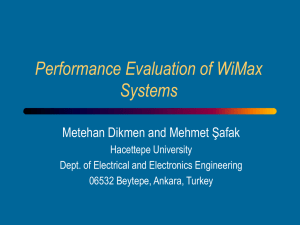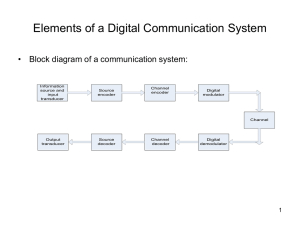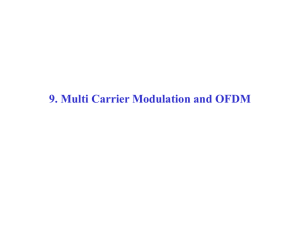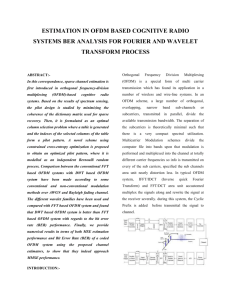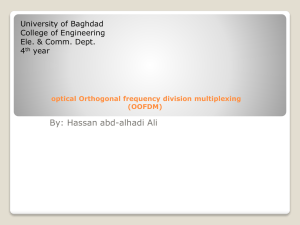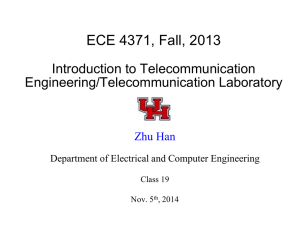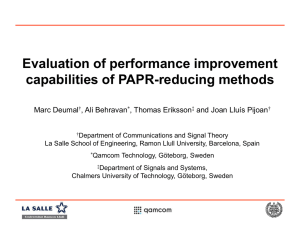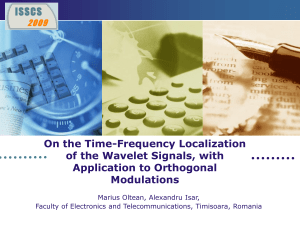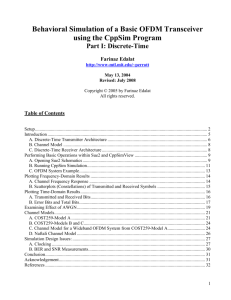Computationally Simple OFDM
advertisement
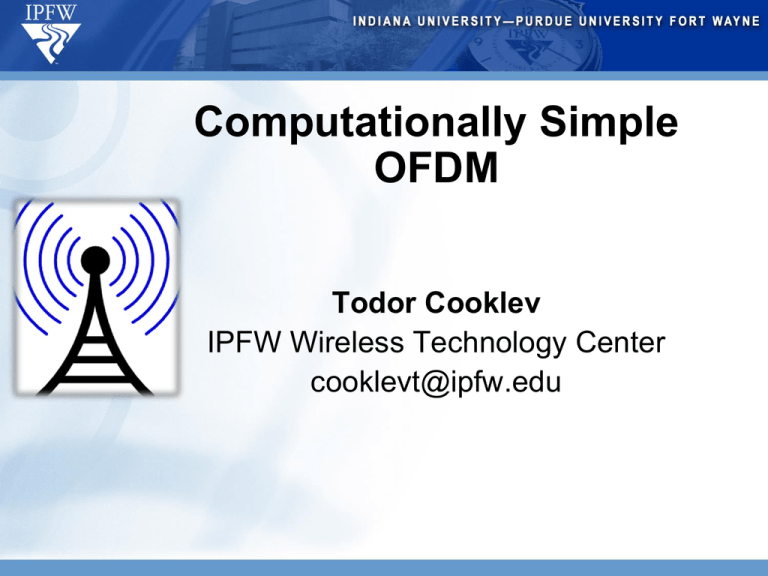
Computationally Simple OFDM Todor Cooklev IPFW Wireless Technology Center cooklevt@ipfw.edu Presentation Overview 1. 2. 3. 4. Introduction Simple OFDM Preliminary Results Conclusions and directions for future research Conventional OFDM Conventional OFDM is based on the discrete Fourier transform; IFFT performs multicarrier modulation S/P bit-to-symbol mapping xcp [m] x[n] X [k ] N-point IFFT Add CP P/S Conventional OFDM receiver: FFT performs demodulation Xˆ [k ] P/S symbol -to-bit H [k ] synchronization Y [k ] N-point FFT Remove CP S/P N-point FFT channel impulse response channel estimation Simple OFDM idea • Can we simplify the DFT/FFT operations? – What would be the system performance – Can we simply the algorithms further? • Make a detailed comparison Rounded DFT idea • The DFT, implemented by the Fast Fourier Transform algorithm (FFT), can be simplified via the rounded sine and cosine functions rcos2 2cos(t ) (t ) 2 rsin 2 2sin(t ) (t ) 2 • Any number of quantization levels can be used 5-level: -1, -0.5, 0, 0.5, 1 9 level: add -0.75, -0.25, 0.25, 0.75 to the above Simple OFDM Definition of standard DFT: k = 0,1,…,N – 1 Using the relationship: the rounded DFT is derived with substitution as follows: k = 0,1,…,N – 1 Two possible inverses • Approximate - the conjugate transpose • Exact – possible, but in general is not multiplierless Simulation • Models of conventional OFDM were created to compare with standard OFDM performance characteristics • Many simulations have be run using the following key parameters: • • • • 64 parallel data channels (64 point DFT/RDFT) QPSK and 16 QAM modulation schemes Quantization levels of 5, 9 and 17 Pairing of IFFT with RDFT Preliminary Results Comparison of conventional OFDM bit error rate with 5 level rounded system -1 10 -2 Bit Error Rate 10 -3 10 -4 10 OFDM QPSK OFDM 16QAM R5L OFDM QPSK R5L OFDM 16QAM -5 10 -6 10 0 5 10 Eb/N0 15 20 Preliminary Results Comparison of conventional OFDM bit error rate with 9 level rounded system -1 10 -2 Bit Error Rate 10 -3 10 -4 10 OFDM QPSK OFDM 16QAM R9L OFDM QPSK R9L OFDM 16QAM -5 10 -6 10 0 5 10 Eb/N0 15 20 Preliminary Results Comparison of conventional OFDM bit error rate with 17 level rounded system -1 10 -2 Bit Error Rate 10 -3 10 -4 10 OFDM QPSK OFDM 16QAM R17L OFDM QPSK R17L OFDM 16QAM -5 10 -6 10 0 5 10 Eb/N0 15 20 Preliminary Results Comparison of conventional OFDM bit error rate with 5 level RDFT paired with standard IFFT -1 10 -2 Bit Error Rate 10 -3 10 -4 10 OFDM QPSK OFDM 16QAM R5L OFDM QPSK R5L OFDM 16QAM -5 10 -6 10 0 5 10 Eb/N0 15 20 Benefits • Currently ASICs are used to implement OFDM • A dedicated OFDM chip (ASIC) contains multiple FFTs – Reduction in chip area • Make possible reconfigurable hardware implementation (FPGA) or even an entirely software implementation (on a DSP or GPP) What we have achieved • Built a software simulation of the new idea • The rounded transform leads to viable OFDM communication systems at specific quantization levels • With performance that approaches conventional OFDM systems • With reduced computational complexity Future Research • Investigate system performance when faced with carrier offset error • Investigate system performance when faced with inter-symbol interference (short cyclic prefix) • Apply the results to systems with multiple antennas • Develop new and simplified algorithms • Investigate the implementation in greater detail Thank you!
